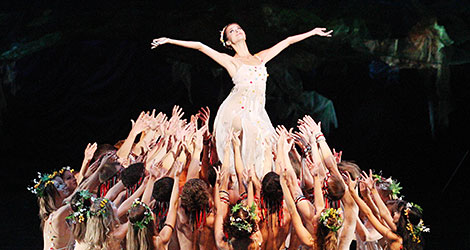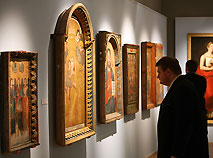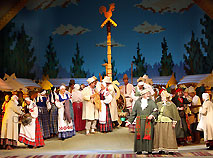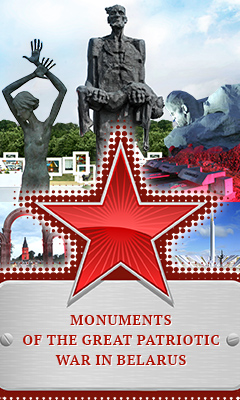Belarus culture

The National Academic Opera and Ballet Theatre
Belarusians develop an appreciation of a rich diversity of culture from a young age – art, music, theatre, literature and more...
History of Art in Belarus
Belarus enjoys a rich cultural and artistic heritage that dates back many centuries, taking in several significant schools of art and architecture and producing many unique musical and literary works.
All surviving masterpieces are now officially protected by the state, and showcased for all to enjoy in museum collections and libraries. Classic works of Belarusian music and drama are regularly staged in concert halls and theatres across the country.
Modern-day art culture in Belarus is equally varied and dynamic. There are numerous art exhibitions, musicals, theatrical performances and cinema festivals – all of which are easily accessible to Belarusians and visitors alike.
Fine Art in Belarus
Fine art in Belarus varies in style, direction and genre. The most captivating work by Belarus artists in different periods can be seen in museums across the country.
The largest collection of works of art are in the National Art Museum of the Republic of Belarus, which actively promotes national art. Exhibitions by local artists are regularly held here. Other prominent museums across the country are the Vitebsk Art Museum, Mogilev regional Art Museum and the Polotsk art gallery.
The history of art in Belarus can be traced back to Byzantine influences in the 14th century, which saw the emergence of iconography and manuscript illustration.
After the October Revolution in Russia in 1917, the northern Belarus town of Vitebsk became the centre for the revolutionary avant-garde movement.
Marc Chagall, one of the most famous Belarusians, was born in Vitebsk in 1887 and founded an art school in the city.
The vast collection of the National Museum of Art in Minsk features the works of Belarusian artists from the 17th to the 20th century, as well as 15th-century iconography.
Music in Belarus
Most people in Belarus can play at least one musical instrument, and music in the country today boasts a mixture of styles and influences.
Classical music performances still draw big audiences. Most popular are:
-
Presidential Orchestra of the Republic of Belarus
-
Mikhail Finberg National Academic Concert Orchestra of Belarus
-
State Academic Symphony Orchestra
-
Grigory Shirma State Academic Choir
-
Gennady Tsitovich National Academic Folk Choir of the Republic of Belarus
-
Belarusian state band Pesnyary
-
Syabry band
-
Pure Voice vocal group
Traditional and folk music still has a big following in Belarus.
Modern pop music is increasingly popular in Belarus. Belarus has been an enthusiastic participant in the Eurovision Song Contest since 2004.
Music festivals are very popular in Belarus. The international arts festival Slavonic Bazaar in Vitebsk has become the symbol of the festival movement of Belarus. Taking part in the festival are popular performers from all over the world.
Theatre in Belarus
Belarus theatre evolved from folk rituals and travelling minstrels. Today the country boasts a diverse range of theatre and drama:
-
puppet theatres can be found in most towns, and are hugely popular with children and adults alike
-
professional theatre companies are active across Belarus, many of them dating back to the early 20th century
-
opera – every major town has its own opera house
-
ballet has been very popular in Belarus since the 18th century, and most towns have their own ballet; the National Academic Bolshoi Theatre of Ballet of the Republic of Belarus has an excellent reputation
Belarus plays host to numerous theater festivals. Prestigious theatrical forums are regularly held in various parts of Belarus bringing together performers from all over the world. The most famous theater forums are:
-
International Theater Festival Belaya Vezha (Brest)
-
International Theater Festival Panorama (Minsk)
-
International Festival of Student Theaters Teatralny Kufar (Minsk)
-
M.art.contact International Youth Theater Forum (Mogilev)
-
International Forum of Theater Arts TEART (Minsk)
-
Belarusian International Festival of Puppet Shows (Minsk).
The audience favorite, Theatrical Meetings, is held within the framework of the International Arts Festival Slavonic Bazaar in Vitebsk.
Belarus cinema
Belarus’ cinematography traces its roots to the 1930s. The Belarusian movie studio Belgoskino was founded in 1924. Founded in 1928 as the studio Soviet Belarus in Leningrad, the studio was moved to Minsk in 1939 and was renamed Belarusfilm in 1946. The studio produced feature, topical and popular science movies.
The Belarus’ first feature movie Liasnaia byl was directed by Yuriy Tarych. Belarusian documentarians were one of the very first to shoot front reports.
Belarus’ post-war movies reproduced the tragic destiny of Belarus people. Belarus filmmakers filled a big niche of their own in children's cinema. The Belarus documentary is recognized worldwide.
Belarus’ modern cinematography carries on the tradition of previous generations, looking for a new pathway. Belarus’ movies are prestigious world film festival award winners. Sergei Loznitsa’s In the Fog based on the novel by Vasil Bykov received the FIPRESCI award at the 65th Cannes Film Festival in 2012.
А lot of movies in Belarus are produced in cooperation with cinematographers from all over the world. Numerous movies were made by Nikita Mikhalkov, Petr and Valerij Todorovskij, Dmitriy Astrahan, Aleksandr Sokurov at Belarusfilm.
Belarus hosts major cinema festivals:
-
the International Film Festival Listapad and the Children and Youth Film Festival Listapadzik (Minsk)
-
the National Festival of Belarusian Films (Brest)
-
the International Animated Film Festival Animaevka (Mogilev)
-
International festival of Christian movies and TV programs Magnificat (Glubokoye)
Literature in Belarus
Books and literature have played an important role among the cultural arts of Belarus for centuries.
Famous writers and poets from Belarus include:
-
Simeon Polotsky
-
Yakub Kolas
-
Maxim Bogdanovich
The turbulent history of the country is reflected in the recurring themes of war, occupation and suffering in Belarusian literature throughout the ages.
Opened in June 2006 in a new hi-tech building, the National Library in Minsk is the copyright library for the Republic of Belarus. A real source of national pride, it boasts the largest collection of Russian-language books outside of Russia.
Day of Belarusian Written Language is an annual holiday. The holiday concept reflects the history of the written language and book publishing in Belarus as well as the development of the Belarusian literature and culture at a present stage.
2012 declared Year of Book in Belarus.







 print version
print version make home page
make home page add to bookmarks
add to bookmarks













